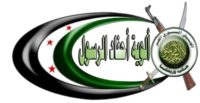|
Ahfad al-Rasul Brigades
The Ahfad al-Rasul Brigades (Arabic: ألوية أحفاد الرسول Al-wiat Aḥfād ar-Rasūl, "Grandsons of the Prophet Brigades") was a Syrian rebel group fighting against the Syrian government in the Syrian Civil War. It was funded by the Qatari government.[15][16] Structure and member groupsIts notable subgroups included the Justice Battalion, the Golan Martyrs Battalion, the Golan Hawks Battalion, the Falcons of Mount Zawiya Brigade,[1] and the Qalamoun Liberation Front.[17] By August 2013, the group had coopted some 50 groups from across Syria; however, it was strongest in Idlib Governorate.[5] Its leader, Colonel Ziad Haj Obaid, was on the Arms Committee of the Supreme Military Council.[1] The Allahu Akbar Brigade, based in al-Bukamal in the Deir ez-Zor Governorate, was also part of Ahfad al-Rasul. In July 2013, Al Jazeera reported that the Allahu Akbar Brigade consisted of around 800 fighters.[2] HistoryOn 11 October 2012, the Ahfad al-Rasul Brigades, in coordination with Ansar al-Islam, conducted a bombing of Syrian military compounds west of the Umayyad Square in Damascus.[13] In December 2012, the Ahfad al-Rasul Brigades executed a Syrian Army officer on allegations of heresy. By this time, the group was described as a Salafist jihadist group independent from the Free Syrian Army.[8] In July 2013, the Ahfad al-Rasul Brigades, along with Ahrar al-Sham and the Kurdish Islamic Front, announced that they would fight alongside al-Qaeda's al-Nusra Front against the People's Protection Units (YPG) in northern Syria.[11] In August 2013, clashes erupted between the Ahfad al-Rasul Brigades and the Islamic State of Iraq and the Levant in the city of Raqqa. On 13 August, ISIL suicide bombers detonated 4 car bombs at the Ahfad al-Rasul Brigades' headquarters at the Raqqa train station, killing 6 Ahfad al-Rasul fighters, including two commanders, Abu Mazin[3] and Fahd al-Kajwan, and 6 civilians.[18] By the next day, ISIL fighters fully captured the headquarter.[19] Clashes also erupted in Tabqa.[18] By 17 August, ISIL had defeated Ahfad al-Rasul in Raqqa and expelled it from the city.[3][20] During the conflict between ISIL and the Ahfad al-Rasul Brigades in Raqqa, the group organized protests against both ISIL and Ahrar al-Sham, and viewed Ahrar al-Sham as allowing ISIL to defeat the group due to their lack of intervention in the conflict, while Ahrar al-Sham also shared the view of ISIL, of the Ahfad al-Rasul Brigades as being a common enemy. However, the Ahfad al-Rasul Brigades announced an end to its conflict with ISIL on 17 August, and resumed cooperation with it.[21] The fighting soon spread to the Deir ez-Zor Governorate, and tensions also rose between Ahfad al-Rasul and the al-Nusra Front. In November 2013, Saddam al-Jamal, commander of Ahfad al-Rasul's Allahu Akbar Brigade, defected to ISIL.[2] Following al-Jamal's defection, 4 subunits of Ahfad al-Rasul also defected to ISIL.[22] By early 2014, the Ahfad al-Rasul Brigades was described as defunct, with many subunits rebranding themselves as members of the Syrian Revolutionaries Front.[4] The Latakia Governorate-based Brigade of the Chargers, formerly part of Ahfad al-Rasul, received BGM-71 TOW anti-tank missiles in early 2014, and became the 1st Coastal Division in late 2014.[23] Reports appeared in early 2017 that possible remnants of the Ahfad al-Rasul Brigades have reappeared as the Army of Grandsons in the northern Aleppo Governorate to fight ISIL as part of Operation Euphrates Shield.[24] See alsoReferences
External links
Information related to Ahfad al-Rasul Brigades |
||||||||||||||||||||||||||
